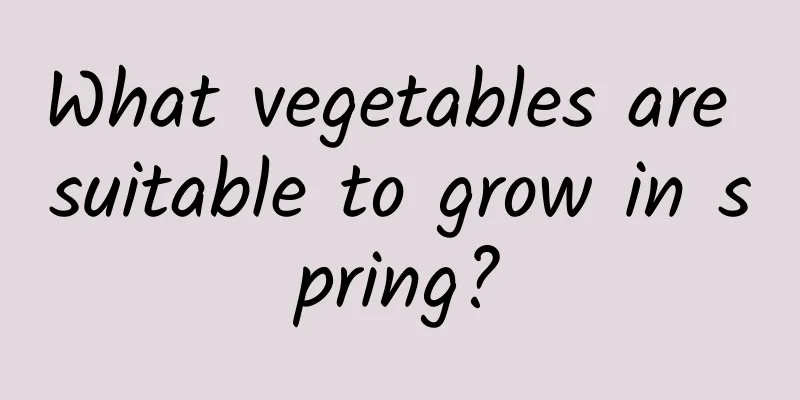Peanut planting and management technology Peanut high-yield cultivation technology and management methods

Sowing timeClimate conditions vary from place to place, so spring and summer sowing are generally adopted. Sowing starts in late March, and it is safer to sow in late April in places with low temperatures. Usually, the minimum temperature for peanut germination is 15℃ . If the temperature is lower than 15℃, the seeds will rot. Therefore, it is important to master the sowing period of peanuts in production, which is an important link to ensure uniform and strong seedlings of peanuts and obtain high yields of peanuts. Land preparationChoose loose, deep, sunny, neutral or slightly acidic soil for planting peanuts. Combined with land preparation, apply enough fertilizer for the peanuts throughout their life. In terms of base fertilizer application, apply 2,000 to 3,000 kg of soil and miscellaneous fertilizers and about 25 kg of phosphate fertilizer per mu. Seed drying + seed mixing + seed soaking① Seed sunning : Sunning peanut seeds in shell before sowing can enhance seed vitality and kill germs carried by seeds. Choose a sunny day and sun the seeds from 10 am to 4 pm every day for 1-3 days. ②Seed dressing : Before sowing, use 0.3% multi-bacteria to flexibly mix the seeds to prevent root rot and base rot. Using 150-200 grams of rhizobia per mu can accelerate the formation of nodules. ③ Seed soaking and germination : Soak the seeds in warm water at about 35 degrees for 2 to 4 hours. If germination is required, place the soaked seeds in a room at 25-30 degrees Celsius for germination. Planting depthThe depth of peanut sowing has a great influence on the emergence and vigor of peanut seedlings. If the sowing depth is too deep, the peanuts are easy to bud or form tall seedlings. If the sowing depth is too shallow, the seedlings will not grow vigorously in the case of little rain, and old and stiff seedlings will be formed. Generally, the sowing depth of peanuts is generally controlled at about 5 cm. After sowing the peanut seeds, cover them with 3 cm of fine soil . Do not cover them with large pieces of soil, otherwise they will easily become budded or even fail to germinate. top dressing① Topdressing during the seedling stage Depending on the degree of nitrogen deficiency and different peanut varieties, apply 5 to 15 kg of nitrogen fertilizer per mu, combined with clearing or tillage and weeding, and apply deep into the soil. Alternatively, apply 5,000 kg of human and animal manure to 2.5-5 kg of nitrogen fertilizer. Mix 15-20 kg of phosphate fertilizer and 50-70 kg of wood ash per mu, then apply deep into the soil layer after cultivating, weeding and trenching. ② Topdressing during flowering period The flowering period is when peanuts need a large amount of fertilizer. The method, type and amount of topdressing are similar to those during the seedling stage. ③ Middle and late topdressing If peanuts have poor growth in the early stage and are not topdressed with large amounts of fertilizer in time, in the middle and late stages, you can soak 1-1.5 kg of phosphate fertilizer per mu in 70-100 kg of clean water for one night, filter the residue and add 50-100 g of urea for foliar fertilization. You can also spray with a 1-2% urea solution. Cultivation and soil cultivationIn peanut cultivation, generally after the peanut seedlings have grown, the soil around the peanut seedlings must be separated to allow the cotyledon nodes to emerge from the ground. If the cotyledons of peanuts cannot emerge from the soil, the cotyledon nodes and the first pair of main fruiting branches cannot develop normally and will die in the soil over time, causing a significant reduction in peanut yields. Peanuts have the characteristics of blooming above ground and bearing fruit underground. Fruit needles must be in darkness and under certain mechanical stimulation conditions to develop into pods normally, so soil needs to be cultivated during the flowering and needle-setting periods of peanuts . |
>>: What are the methods and precautions for raising Qilin? How to raise Qilin flowers
Recommend
How much water should be given to gardenia per day?
1. How much water should be poured per day Althou...
The efficacy and function of Hemeng
one. Green manure value Green manure crops refer ...
Can hibiscus trees be planted in the yard?
Can I plant a hibiscus tree in my yard? Hibiscus ...
How to breed red larvae
1. Beheading reproduction 1. Choose healthy branc...
How to change the pot and soil of green radish
1. Preparation If you plan to change the pot and ...
How to plant hibiscus flowers? Planting time and method
Hibiscus planting time Hibiscus can generally be ...
When is the best time to plant Wutacai?
Wutacai , also known as Tacai, is named black veg...
Is the Aspidistra poisonous?
Is it toxic? Aspidistra is an evergreen plant tha...
Is rice self-pollinating or cross-pollinating (the main pollination method of rice flowers)
The main pollination method of rice flowers Rice ...
Saffron growth environment conditions and characteristics
Saffron growth environment conditions and require...
The efficacy and function of crabapple, crabapple pictures
1. Provide nutrients Crabapple is edible and cont...
How to prune hydrangeas?
In the process of caring for hydrangeas , pruning...
How to water newly planted asparagus fern
Watering the newly planted asparagus fern Newly p...
Why is the loofah I grow bitter? (Why is the loofah I grow bitter?)
Causes and preventive measures of bitterness in b...
Tomato cultivation methods and precautions
1. Maintenance methods 1. Temperature: The most s...









